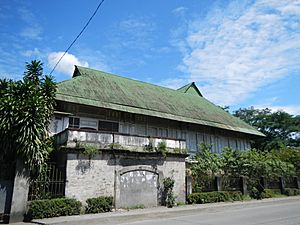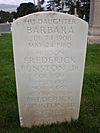Frederick Funston facts for kids
Quick facts for kids
Frederick Funston
|
|
|---|---|

Major General Frederick Funston
|
|
| Nickname(s) | "Fearless Freddie" |
| Born | November 9, 1865 New Carlisle, Ohio, U.S. |
| Died | February 19, 1917 (aged 51) San Antonio, Texas, U.S. |
| Place of burial | |
| Allegiance | |
| Service/ |
|
| Years of service | 1898–1917 |
| Rank | |
| Commands held | Hawaiian Department |
| Battles/wars | Spanish–American War Philippine–American War Occupation of Veracruz Bandit War |
| Awards | |
| Spouse(s) |
Eda Blankart Funston
(m. 1898) |
| Children |
|
| Relations |
|
| Signature | |
Frederick Funston (born November 9, 1865 – died February 19, 1917) was a brave general in the United States Army. People sometimes called him Fighting Fred Funston or "Fearless Freddie." He is most famous for his actions during the Spanish–American War and the Philippine–American War. He even received the Medal of Honor, which is the highest award for bravery in the U.S. military.
Contents
Early Life and Education
Frederick Funston was born in 1865 in New Carlisle, Ohio. When he was two years old, his family moved to Allen County, Kansas. His father, Edward H. Funston, later became a politician and served in the U.S. House of Representatives.
Funston was a small person, standing only 5 feet 4 inches tall and weighing about 120 pounds. In 1886, he tried to join the United States Military Academy at West Point, but he was not accepted. He graduated from Iola High School in 1886. Then, he attended the University of Kansas from 1886 to 1890. After college, he worked for a railroad company and later became a reporter in Kansas City, Missouri.
Military Career and Adventures
After working as a journalist for a year, Funston became interested in science. He joined an expedition to explore Death Valley, California. In 1891, he traveled to Alaska and spent two years working for the United States Department of Agriculture.
Fighting in Cuba
In 1896, Funston was inspired by a speech and decided to join the Cuban Revolutionary Army. This army was fighting for Cuba's independence from Spain. He became a part of their fight for freedom.
After getting sick with malaria, Funston became very weak. He returned to the United States to recover. On May 13, 1898, he joined the United States Army as a colonel in the 20th Kansas Infantry. This was at the beginning of the Spanish–American War. Soon after, he met Eda Blankart and they got married on October 25, 1898. Just two weeks later, he left for the Philippines to join the U.S. forces in the Philippine–American War.
Hero in the Philippines
Funston led his troops in many battles against Filipino nationalists. In April 1899, he showed great courage by swimming across the Bagbag River and then the Pampanga River under heavy enemy fire. He captured a Filipino position at Calumpit. Because of his bravery, Funston was quickly promoted to brigadier general and received the Medal of Honor on February 14, 1900.
Funston played a very important role in capturing the Filipino President, Emilio Aguinaldo. On March 23, 1901, Funston and his team, disguised as prisoners, entered Aguinaldo's camp at Palanan. This clever plan led to Aguinaldo's capture. This made Funston a national hero in the U.S. He was appointed a brigadier general in the Regular Army at just 35 years old.
However, some people, like writer Mark Twain, criticized Funston's methods for capturing Aguinaldo. They believed his actions were not fair. President Theodore Roosevelt even had to officially scold Funston for making insulting comments about a senator who opposed U.S. expansion.
Sideco House: A Historic Headquarters
The Sideco House in San Isidro, Nueva Ecija, is a very important historical building. It was used as the headquarters for General Emilio Aguinaldo's First Philippine Republic. He stayed there during his escape from American forces.
On March 29, 1899, General Aguinaldo declared San Isidro the capital of the First Philippine Republic and used this house as his government's base. Later, after American forces took San Isidro, the Sideco House became Funston's headquarters. It is believed that the plan to capture General Aguinaldo was made in this house. Today, a Christian organization uses the house.
Back in the United States and Overseas
In 1906, Funston was in charge of the Presidio of San Francisco when a huge 1906 San Francisco earthquake hit. A terrible fire followed the earthquake. Funston quickly took charge, even though he didn't have official permission to declare martial law. He tried to stop the fires by blowing up buildings to create gaps, but sometimes this made the fires worse. He also ordered soldiers to shoot anyone caught looting. While local officials praised his actions at the time, some historians later questioned if using military force in a peacetime emergency was the best approach.
Funston also served as commandant of the Army Service School in Fort Leavenworth. He then spent three years as commander of the Department of Luzon in the Philippines. He also briefly commanded the Hawaiian Department.
From 1914 to 1916, Funston was involved in conflicts with Mexico. As commanding general of the army's Southern Department, he was promoted to major general in November 1914. He led forces that occupied the city of Veracruz. He also commanded the troops who searched for Pancho Villa and helped protect the U.S. border during the "Bandit War".
World War I and Passing
Before the United States entered American entry into World War I in April 1917, President Woodrow Wilson thought Funston would be a great leader for any American forces sent overseas. However, Funston worked very hard, which affected his health. In February 1917, at the age of 51, he had a fatal heart attack in San Antonio, Texas.
Just before he passed away, Funston was listening to an orchestra play music in a hotel lobby. He was holding a six-year-old girl in his arms when he said, "How beautiful it all is," and then collapsed.
Douglas MacArthur, who was a major at the time, had the sad job of telling President Wilson the news. Funston's body lay in state at the Alamo and at the San Francisco City Hall. He was the first person to receive this honor at San Francisco City Hall. He was buried in the San Francisco National Cemetery.
After Funston's death, Major General John J. Pershing took his place as commander of the American Expeditionary Force. Many places were named in Funston's honor, including Fort Funston in San Francisco, Camp Funston in Kansas, and several streets in different cities. His daughter, son, and grandson, who both served in the United States Air Force, were later buried with him.
Legacy and Honors
Many places are named after Frederick Funston to remember his service and bravery:
- Fort Funston in San Francisco, California, is a military fort named for him.
- Streets are named for Funston in San Francisco, New Carlisle, Ohio, Reading, Pennsylvania, Fort Leavenworth, Kansas, Pacific Grove, California, and Hollywood, Florida.
- Part of Fort Riley, Kansas, was also named for him.
- Funston Road at Schofield Barracks and Fort Shafter in Hawaii are also named after him.
In Popular Culture
- In the 2012 Filipino movie El Presidente, Frederick Funston was played by actor Troy Montero.
- He was also played by Pablo Espinosa in the 1997 TV series Rough Riders.
- He was mentioned in The Woggle-Bug Book by L. Frank Baum, published in 1905.








